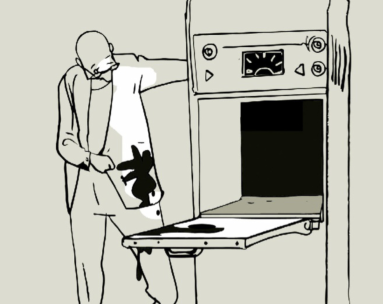A melted candy bar helps create the microwave oven.
一款融化的糖果促進(jìn)了微波爐的發(fā)明。
Percy Spencer was so fascinated by the sinking of the Titanic that he became a scientist.
珀西·斯賓瑟對泰坦尼克號的沉沒非常著迷,以至于他成為了一名科學(xué)家。
He joined the Navy, trained as a radio electrician, and ultimately became a civilian expert on radar during World War II,
他加入了海軍,受訓(xùn)成為無線電電工,并最終在二戰(zhàn)期間成為一名民用雷達(dá)專家,
earning the Distinguished Public Service Award for his work.
憑他的工作贏得杰出公共服務(wù)獎。
But he did it all without ever having graduated from high school.
而他這一切都是在高中沒有畢業(yè)的情況下完成的。
After the war, Spencer worked for Raytheon Manufacturing, a defense contractor.
戰(zhàn)后,斯賓塞為雷聲制造公司工作,這是一家國防承包商。
As he was walking near the radar equipment one day, he absent-mindedly stuck his hand in his shirt pocket—and found a gooey mess.
一天,當(dāng)他走到雷達(dá)設(shè)備附近時(shí),他心不在焉地把手伸進(jìn)襯衫口袋,發(fā)現(xiàn)了一團(tuán)黏糊糊的東西。
Spencer often carried a Mr. Peanut candy bar to feed the squirrels at lunch.
斯賓瑟經(jīng)常帶一個(gè)花生糖果在午餐時(shí)喂松鼠。
He knew enough about radar to suspect that its heat-producing magnetron waves could be the culprit, but he wasn’t sure.
他對雷達(dá)有足夠的了解,懷疑它產(chǎn)生熱量的磁控管波可能是罪魁禍?zhǔn)祝淮_定。
So he placed a bag of popcorn kernels in front of the machine— and they popped.
于是他把一袋玉米粒放在機(jī)器前,結(jié)果玉米粒就爆了出來。
Then came a raw egg, which dutifully exploded all over a skeptical colleague’s face.
然后又拿來一個(gè)生雞蛋,它盡職地炸了一個(gè)持懷疑態(tài)度的同事一臉。
Spencer fine-tuned his discovery with Raytheon and marketed it to airlines, railways, restaurants,
斯賓瑟和雷聲公司對他的發(fā)現(xiàn)進(jìn)行了微調(diào),并將其作為“雷達(dá)爐”推廣到航空公司、鐵路、餐館、
and cruise liners as “the Radarange”—or, as it’s known now, the microwave oven.
客輪公司-它就是我們現(xiàn)在所說的微波爐。
Fortunately, microwaves have come a long way since 1947,
幸運(yùn)的是,微波爐自1947年以來走了很長的一段路,
when they stood nearly six feet tall, weighed 750 pounds, and cost $3,000. That’s roughly $35,000 today.
那時(shí)它們高近6英尺,重750磅,價(jià)值3000美元。那差不多相當(dāng)于今天的35000美元。
A coconut saves JFK’s life. August 2, 1943, began as a cloudy, moonless night in the South Pacific for 26-year-old Navy lieutenant John F. Kennedy.
一個(gè)椰子救了肯尼迪的命。1943年8月2日,26歲的海軍中尉約翰·F·肯尼迪在南太平洋開始了一個(gè)多云、沒有月亮的夜晚。
As Kennedy and his crew patrolled the Solomon Islands from their boat, PT-109, a Japanese destroyer pierced through the fog and sliced the smaller ship in half.
當(dāng)肯尼迪和他的船員們乘坐PT-109號船在所羅門群島巡邏時(shí),一艘日本驅(qū)逐艦穿過霧氣,把他們的小船劈成了兩半。
An enormous fireball filled the sky, and two men aboard PT-109 were killed.
一個(gè)巨大的火球充滿了天空,PT-109號船上兩個(gè)人身亡。
As Kennedy and ten other survivors huddled around the wreck, they realized they had no choice but to swim to a nearby island.
肯尼迪和其他十個(gè)幸存者擠在沉船周圍,他們發(fā)現(xiàn)別無選擇,只能游到附近的一個(gè)島上。
Kennedy, a former member of the Harvard swim team, personally towed one of his wounded comrades with his teeth
肯尼迪曾是哈佛游泳隊(duì)的一名成員,他用牙齒拖著一名受傷的戰(zhàn)友,
for five hours through shark- and crocodile-infested waters to Plum Pudding Island, where they ate coconuts to survive.
游了5個(gè)小時(shí)穿過鯊魚和鱷魚出沒的水域,來到葡萄干布丁島,在那里他們靠吃椰子生存。

After several days, the men flagged down two Solomon Islands natives passing in a canoe, who agreed to take a message to the Allied forces.
幾天后,這些人揮手示意兩名乘船經(jīng)過的所羅門群島的土著,他們同意給盟軍捎口信。
The dispatch was carved into a coconut shell: “NAURO ISL ... COMMANDER ... NATIVE KNOWS POS’IT ... HE CAN PILOT ... 11 ALIVE ... NEED SMALL BOAT ... KENNEDY.”
急件被刻到了椰子殼上:“諾魯島...長官...本地人知道在哪里...他可以領(lǐng)航...有11個(gè)人還活著...需要小船...肯尼迪。”
The islanders delivered the coconut, and the men were soon rescued.
島民們把椰子送了出去,這些人很快就獲救了。
Years later, Judge Ernest W. Gibson Jr., a colonel in the South Pacific during the war, surprised the newly elected President Kennedy with a gift.
幾年后,法官小歐內(nèi)斯特·W·吉布森送給新當(dāng)選的肯尼迪總統(tǒng)一份禮物,令他大吃一驚。吉布森戰(zhàn)時(shí)在南太平洋任上校。
It was the coconut he had carved his message into. Kennedy had it encased in plastic and used it as a paperweight throughout his presidency.
禮物就是他當(dāng)時(shí)刻字的椰子。肯尼迪把它用塑料包裹起來,并在他的總統(tǒng)任期內(nèi)把它用作鎮(zhèn)紙。
Today, it is on permanent display at the John F. Kennedy Library in Boston.
如今,它在波士頓的約翰·肯尼迪圖書館永久展出。



